Choosing the right product can make or break a business. While some entrepreneurs focus on year-round bestsellers, others tap into the potential of seasonal products—items that see demand spikes during certain times of the year.
Seasonal products can be highly profitable, but they also carry the risk of becoming dead stock.
Success depends on more than just choosing the right products; it requires careful planning, from managing inventory to executing timely marketing strategies.
In this article, we’ll explore what seasonal products are, the pros and cons of selling them, and practical tips to maximize your success.
By the end, you’ll have a clearer understanding of whether seasonal products are the right fit for your business.
Let’s dive in.
What Are Seasonal Products?
Seasonal products are items that experience high demand during specific times of the year.
Unlike products with steady sales throughout the year, seasonal products have sales that peak during particular seasons, holidays, or events.
Like winter coats are in high demand during colder months, while Halloween costumes see a sales boost in October.
These products can be tied to weather changes, holidays, or cultural events, and they often become less popular once the season or occasion passes.
What Is Seasonal Stock?
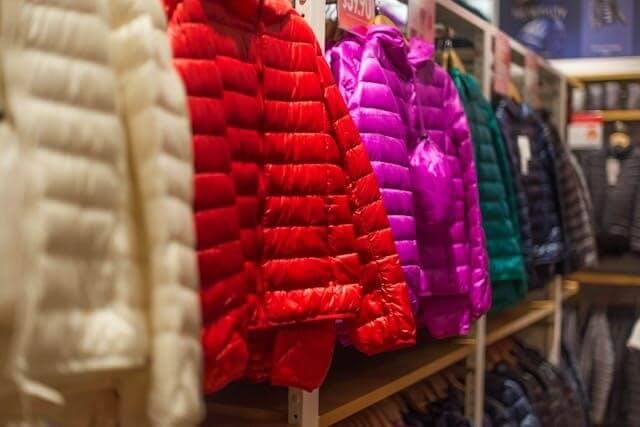
Seasonal stock is the inventory that businesses keep for products that sell well during certain times of the year. These items are put on shelves in anticipation of increased demand during specific seasons, holidays, or events.
Managing seasonal stock means figuring out how much of each product to keep in stock. This requires careful planning to make sure businesses don’t order too much or too little.
If a business has too much stock, they might end up with leftover items that they can’t sell; if they don’t have enough, they could miss out on sales when customers are looking to buy.
When businesses handle their seasonal inventory well, they can increase their profits and lower the chances of being stuck with unsold goods after the busy season ends.
Seasonal Products Examples
There can be many examples that fall under seasonal products. Here are more of them listed below.
- Swimwear in the summer months
- Snow covers and gloves in winters
- Valentine’s day flowers
- Holiday season items for Christmas and new year.
These are only a few examples of seasonal products. You will see more examples in the following section.
Types of Seasonal Products
Seasons come and go, and so do seasonal products. They evolve based on current trends, consumer demands, and holidays.
From our experience of sourcing products for various clients, we can categorize seasonal products into the following fivetypes.
- Weather-specific Products
- Occasional Products
- Fluctuating Trends
- Products with Sudden Demand
- Time-bound Items
Let us discuss each of them briefly.
Weather-specific Products
These products are influenced by weather or climate conditions, with demand varying significantly based on whether it’s cold or hot outside.
For example, beanies and jackets are the products with the most demand in the winter or fall season.
On the contrary, beach towels and sunshades are the high selling items in summers.
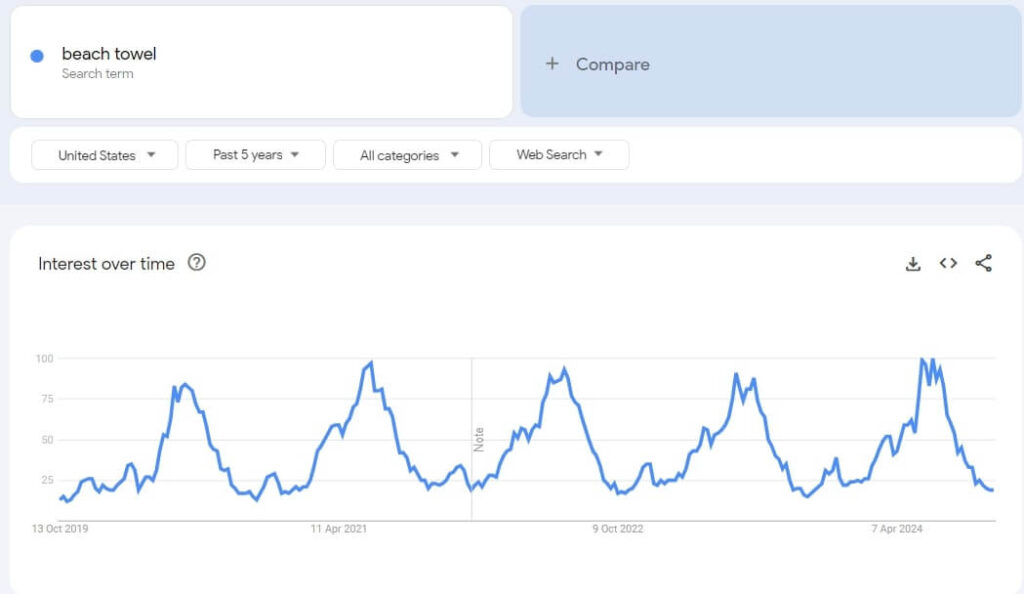
You can see from the screenshot of Google Trends above that the demand for beach towels arises every summer season.
So, these are the products in demand as per their relative weather or climate. Most general stores replace the items from the previous season with the items of the current season.
This is true for both physical and online stores.
Occasional Products
Another type of seasonal product is the items that sell high as per the occasion or a particular event. An occasion or an event can happen at different times around the year.
For example, Christmas is one of the most important events in western countries. So are Halloween and the new year. These occasions or events have huge demands for products related to the event.
You will see a lot of advertisements regarding funny and scary items just before Halloween. Similarly, you will also find a lot of products regarding Christmas and the ads start to pour in right around Christmas time every year.
Have a look at the screenshot from Google Trends below.

These products are not sold all around the year. Whether the sellers have these items in their stock or not, they only sell during a certain time.
Apart from such religious and cultural events, the occasional products are also sold when particular social events or customs occur at a specific time of the year.
For example, if there’s a wedding season in a region, it will have plenty of products related to the wedding ceremony.
Fluctuating Trends
There are some products that are influenced by trends that are not permanent. Rather these products keep having an upward and downward trend in their demands.
For example, if there is an election season going on in the US or any other country, that region is going to have a lot of products related to elections.
It is when products like Republican and Democrat caps have high demand in the US.
Another example is the FIFA world cup which also happens every four years. This is the time when you will see a lot of t-shirts having pictures of Messi and Ronaldo along with other products.
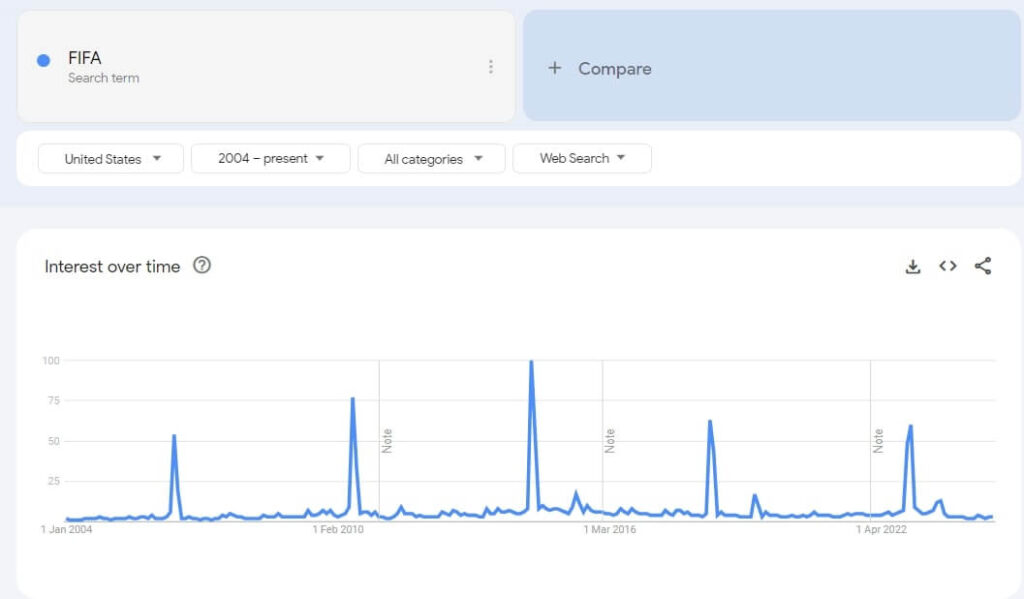
Both US elections and the FIFA world cup are huge trends but they only repeat after four years. So, they are also seasonal products.
Products with Sudden Demand
You must have noticed that some products have sudden demands. They may be due to a specific reason or a particular trend that arises out of nowhere.
The world recently witnessed the Covid-19 pandemic when every part of the world was either affected or took precautions not to be affected by the virus.
This was the time when we saw an insanely sudden demand for products like facial masks and hand sanitizers. The demand was so high that these products suffered a shortage for many months all over the world.
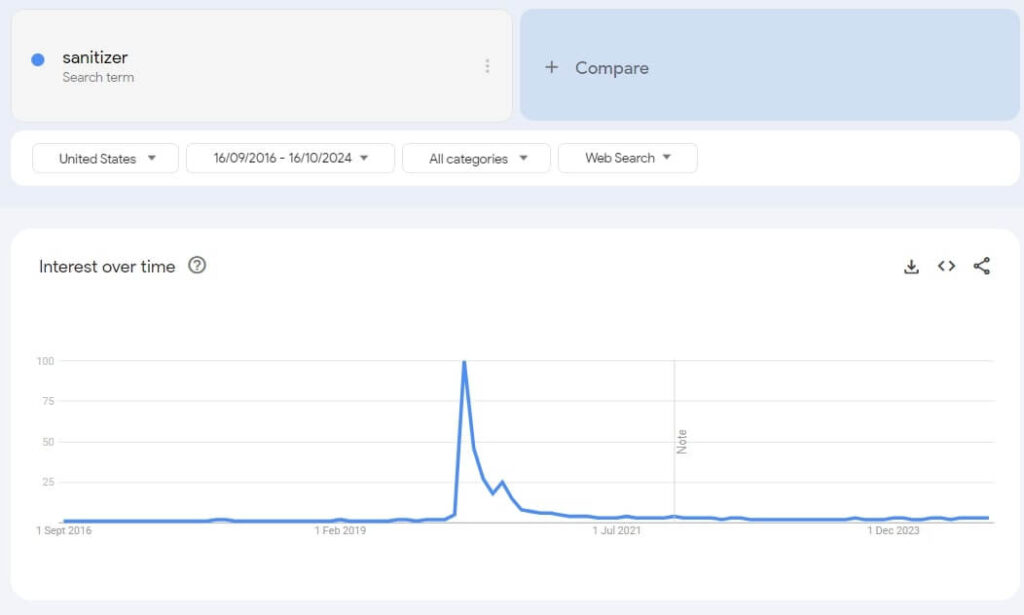
Although this had been a tough time for everyone this was somehow the golden period for sellers especially online sellers.
Those who had managed to arrange masks and sanitizers or had them in their stock started selling these products for the prices of their choice.
The demand for such items was sudden at the end of 2019 and almost during the complete year of 2020 but after that, you can see that since mid 2021, it’s hardly receiving any search volume.
There are probably still many online stores with loads of hand sanitizers and face masks in their inventory. We won’t entirely say it’s dead stock but thankfully, it’s not as in demand as it once was.
So, these are times when it is advisable to start selling these seasonal products. Just to be clear, this is merely an example, and we do not advocate profiting from a pandemic.
Time-bound Items
If you have had an interest in selling things online since 2017, you must remember a product that took the world into its charisma. Yes, we are talking about the fidget spinners. This is the product that the internet got crazy for.
The demand for this product suddenly rose in 2017 and reached every corner of the world. This was the time when almost everyone needed a fidget spinner.
Have a look at the Google Trends below.

As you can see, there has been almost no interest in this product before or after 2017. This means that this product had a time-specific demand.
Those who started selling fidget spinners at the right time in 2017 must have got a lucrative share in its sales.
But consider if someone decides to start selling fidget spinners in 2022 when it attracts almost no interest from the public. Yes, it won’t be a good idea.
That is why we call them time-bound items. It is only beneficial if you sell those products at the right time.
Other examples of time-bound or time-specific products are the fashion items that attract the audience’s interest at a specific time.
Say the superhero movies for example. We keep hearing about the release of superhero movies from time to time. They include some of the most-liked characters including Superman, Spiderman, X-men, etc.
The audience is generally desperate to watch the new movies from such series. That is what the sellers are also waiting for.
So, when the time is right, the sellers start selling the superhero t-shirts for the passionate audience of such characters or the gadgets used in those movies to attract those customers.
We witnessed the booming sales for Harry Potter’s stick and necklaces when that series was at the top.
But again, timing is all that matters in such cases. If someone starts selling the dragons from Game of Thrones years after its last episode, it won’t be a very good idea.
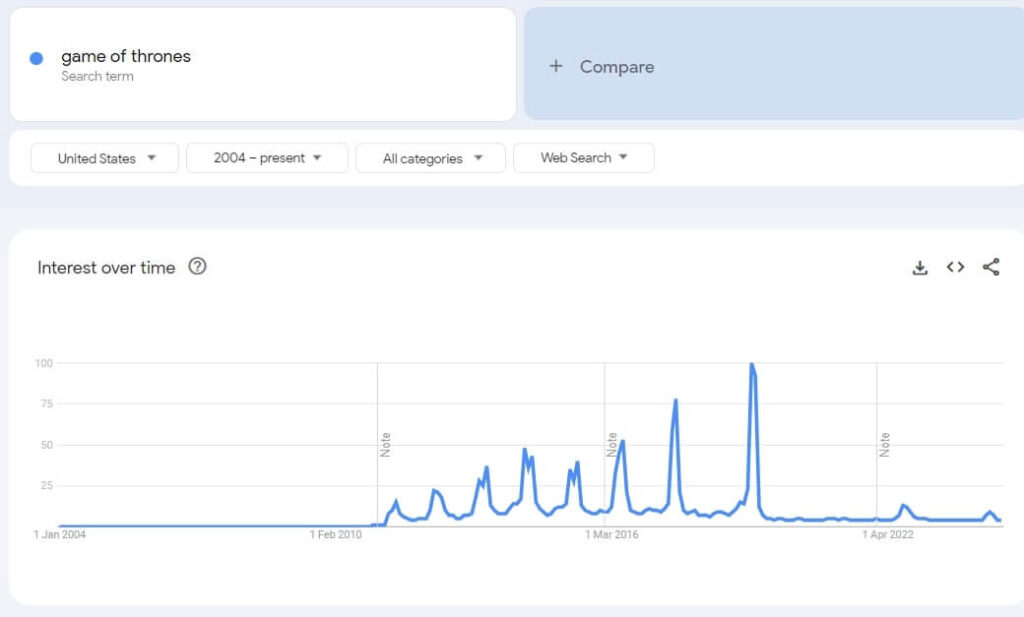
But you can see the sudden surge in demand year after year, especially when a new season dropped.
Seasonal Inventory Management Strategies
Effectively managing seasonal inventory is key to maximizing profits and minimizing waste. Here are some strategies to consider:
- Forecast Demand: Analyze historical sales data and market trends to predict which products will be in high demand during specific seasons. Use tools like trend analysis for better accuracy.
- Flexible Planning –Develop adaptable inventory plans that can quickly respond to demand fluctuations. Techniques like just-in-time inventory help minimize excess stock.
- Monitor Stock Levels –Regularly track inventory and sales performance to identify trends. Inventory management software can assist in maintaining optimal stock levels.
- Build Supplier Relationships –Maintain strong communication with suppliers to negotiate terms for smaller, frequent orders. This ensures quick restocking and reduces excess inventory.
- Clearance Strategies –Implement clearance sales or product bundles to manage leftover inventory after peak seasons, making room for new products.
By applying these strategies, you can proactively meet customer demand and enhance your success in selling seasonal products.
Pros and Cons of Selling Seasonal Products
Selling seasonal items comes with certain advantages and disadvantages. Let’s discuss them quickly.
Pros of Seasonal Products
Following are the advantages of selling seasonal products.
High Demand
As we discussed earlier, seasonal products have high demands provided the time is right. So, you can enjoy huge sales at certain times that would also translate into high revenue.
Less Competition with Niche and General Stores
If you are focused on selling seasonal products, you won’t be having direct competition with the niche stores.
For example, a store selling the items for home decor won’t be competing with you if you are selling the items related to football.
So, in a way, you have less competition than the mainstream and regular products.
Element of Passion
Specific seasonal items have a more passionate audience as compared to the general products. Therefore, you can take advantage of this aspect and target the passionate customer base more easily.
Better Product Planning

As seasonal products appear in demand from time to time, you get enough room to plan or source your products in advance.
This is especially true in the cases of fluctuating trends and weather-specific products.
Higher Pull-sale
Pull sales and push sales are the two most common selling techniques. Seasonal products have higher pull sales. That means that consumers are already searching for those products.
Unlike other products, you don’t have to create the demand for seasonal products by spending a lot of budget on marketing campaigns. The demand for these products is already there in most cases. You just have to fulfill those demands.
Product Variety
Another advantage of selling seasonal products is that there is a huge variety of these products. One seasonal product may be completely different from the other.
So, what is the advantage here? This variety of products keeps your interest alive for selling these products using different techniques.
This also compels you to try out different selling strategies. You might get your hands on a selling strategy that changes your business for good.
Cons of Seasonal Products
Let’s discuss the disadvantages of selling seasonal products.
Low Product Lifespan
As seasonal products are not necessarily in demand throughout the year, these products have a low lifespan. There may also be occasions that you only sell a set of seasonal products for as long as a month or two.
Risky Overstocking
If you order a lot of products after observing a huge demand for a seasonal item and that demand suddenly plunges, it could be a problem for you to handle the unsold items.
Strict Delivery Times
Seasonal products are time-specific products. You need to follow the delivery timing strictly to ensure that the products reach your customers while the season for those items is still going on.
What if your customer gets a product he ordered for winters at a time that is close to summers? It is likely that he might refuse to accept that product.
That can incur the charges of returns and refunds.

Product Sourcing Issues
As discussed earlier, some seasonal items suddenly emerge in demand out of nowhere. In those cases, the products are readily available to all the manufacturers or suppliers.
So, it can be challenging for you to arrange products even if you buy from China.
Top 10 Tips to Maximize Your Seasonal Products Business
Here are a few professional tips if you decide to launch a business selling seasonal items.
1. Keep in Touch With Trends
First of all, you will be in a better position to market seasonal products only if you know what they are. If you won’t be updated with the latest trends, you can miss out on the seasonal opportunities.
You can join the groups, pages, and forums that discuss the latest trending products. You will get a lot of product ideas there.
2. Be Ahead of Your Competition
Always do competitor research and try to have a keen eye on your competitors. Keep following what products they are selling at what times.
You must have all the major products in your store that your competitors have and one-up them by bringing something unique to the table, if possible. That is the way to knock out your competition.

3. Have Regular Employees
Some seasonal sellers tend to work only in a particular season and after the season is gone, they stop working until the next season.
This costs them a lot of factors. Losing employees is probably on top of the list. Try retaining your core employees at all times because it is always difficult to find the right employees when you resume work.
4. Use Broad Keywords for better SEO
SEO is a technique of staying relevant for as long you want. Therefore, instead of using specific time-bound keywords, try using general and broad keywords in your content strategies.
That is because you would want your site to remain relevant for search engines even after the season is over.
5. Market Yourself as a Brand
People generally believe a brand instead of the business that has suddenly appeared only to be found nowhere after a certain time period.
Try marketing your business as an established brand so that your customers have an idea that they are buying from a brand that will always be there to support them.
Even if you’re dropshipping, find a supplier or service to help you with product branding.
6. Single Product Store for Hot Items
This is a very good technique especially for selling hot and trending items. In addition to keeping the hot item in your store, you can also make an online store that only sells that particular item that has crazy demand.
This can bring you more sales from both stores.
7. Flawless Customer Service

Most customers do not return to the same seasonal brand after purchasing items because of bad customer service. If you want to play big, you have to provide exceptional and flawless customer service.
This will make your customers return to your store again to buy other seasonal products.
8. Upsell and Cross-sell Techniques
Don’t just depend on the sale of a single product. If a customer buys a seasonal product from your store, try hooking your customer with another related product for cross-selling.
You should also suggest to your customers the high-end products if they have bought a low-priced product from your store. That is how the sales are maximized.
9. Use Efficient Sourcing
Sourcing products and delivering them to your customers’ addresses are the key to the successful selling of seasonal products.
Do consider hiring the services of a product sourcing agent so that you can focus more on bringing sales.
A good product sourcing agent like AsianDavinci knows where to find products from. So, you can save time in searching for the products and focus on building your business while letting a sourcing expert do his job.
10. Update Your Store Regularly
Your store can’t afford to have a consistent set of products at all times. If y
ou want to sell seasonal products, you need to update your store as per the season or the trend.
FAQs about Seasonal Products
Summary
So, should you sell seasonal items? If you are willing to use the tips and tricks shared in this article, it is advisable to sell these varying products.
You just need to stay connected to the demand trends and keep your supplies on time. You can rock as a trusted brand for seasonal products in your area or even all across the world.
Do you need a reliable sourcing partner? Consider asking for a free quote from us. Our representative will be right there to assist you with sourcing the best quality products from China at affordable prices
